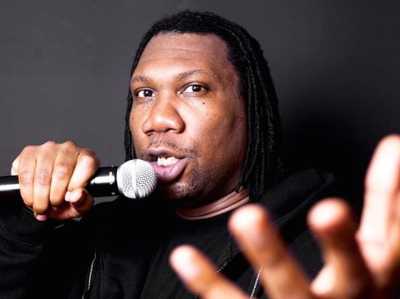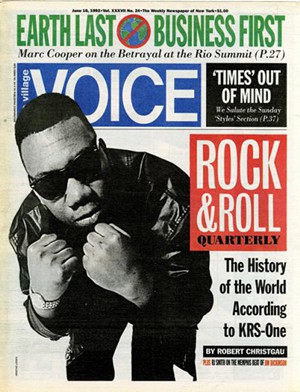| |
Taken from Village Voice (December 30, 2015)
KRS-One: ’Technology Is Attempting to Manipulate Hip-Hop’
by Christopher Harris

KRS-One: Courtesy of KRS-One |
At 26, KRS-One sneered, crouched, and raised his fists in a fighting stance on the cover of theVillage Voice’s June 1992 Rock 'n' Roll Quarterly edition. Within a sprawling twenty-two-page Q&A, penned by Robert Christgau, the Voice examined the young rapper’s ideologies in a cover story titled "The History of The World According to KRS-One." Having reviewed all five of Boogie Down Productions' studio albums, from Criminal Minds to Sex and Violence, Christgau identified at the time that the group’s outspoken frontman was “certain to remain a revered rap elder."
He was right. At age 50, KRS-One, born Lawrence “Krisna” Parker, is as exalted as can be in the genre, and the tenured, self-proclaimed “teacha” is pushing for proper hip-hop education on college campuses. His latest album, Now Hear This, finds KRS-One edutaining once more about societal injustices: a failed war on drugs, the Confederate and American Flag both standing as symbols of hatred, and immigration reform, among other topics. Over boom-bap beats reminiscent of rap’s golden age, KRS-One delivers his distinct message through unfiltered rhymes chock full of subject matter you’re more likely to hear at a town hall meeting than on the radio.
“I didn’t make this album hoping to get rich, or even to make some kind of 'comeback,'" he tells the Voice via e-mail. “Now Hear This speaks to the cries, concerns and hopes of hip-hop’s real citizenry — those committed people that actually come to the concerts, to the lectures and to the workshops — which is [my] actual fan base… This album was made in response to the cries of my people for a more substantive presentation of hip-hop. My citizenry, my true hip-hop citizenry, demanded this presentation from me, and so — there it is!”

The 1992 edition of Rock 'n' Roll Quarterly
Kristine Larsen for the Village Voice |
In order to make sure Now Hear This didn’t fall on deaf ears, KRS-One released the eighteen-track offering exclusively online – for free, with an option to purchase. For the first time in his career, the pioneering rapper who has recorded albums under RCA, Jive, Duck Down, and Koch is independent and operating on his own terms. His wife, Simone G. Parker, currently serves as his manager and publicist (she coordinated this interview), and is also credited as the executive producer of Now Hear This. Her poem “Oh Cruel Mob” concludes the project and KRS-One admits that he "did not name the album; Simone did.”
“It is important that people hear something regarding hip-hop that deals with the salient issues of the day,” says Simone. “Hip-hop’s global image cannot, and is not, the same five songs we hear on the radio every day.” The couple plans to re-release Now Hear This in 2016, complete with videos, additional songs and remixes appearing on a CD version. In the twenty-some years since KRS-One posed – in his freshest Nineties garb – for his sole Voice cover, hip-hop has exploded into the mainstream, becoming a billion-dollar industry and a teachable subject. The accolades have been far and few for him (one Grammy nomination, one BET Hip-Hop Lifetime Achievement Award, one VH1 Hip-Hop Honor), and the allure surrounding his stock has dwindled. His political barbs no longer reverberate through radio speakers; they’re an acquired taste for hip-hop purists. Still, KRS-One is at the half-century mark and showing no signs of stopping. “I am always recording something somewhere, but today’s outlets for rap and rappers/emcees is so over-saturated and ‘kiddy’ that serious emcees like me are hardly ever really heard through such outlets,” he says. “I’ve been working ceaselessly since 1986; I’ve never stopped, or retired, or even took a real hiatus — I probably need one. But, I am not a mainstream rapper; I am hip-hop!”
With a catalogue that consists of close to thirty albums — twelve solo, six B.D.P., and a handful of other collaborations — KRS-One's declaration doesn’t sound too far-fetched. He’s evolved alongside the genre he proudly claims to personify. And he’ll quickly clarify how “Hip-hop is doing great; it’s rap music that is suffering.”
| 'This album was made in response to the cries of my people for a more substantive presentation of hip-hop.' |
The old school emcee is critical of the youth, but he says “the millennial generation seems to respect and even understand KRS-One
more than their parents do and did.” “Young people may be stupid at times,” he adds, “but they respond to the truth when it is present, and for them KRS-One is the truth!”
Though he's active on Facebook, Instagram, and Twitter – with a cumulative outreach of 300,000-plus people – his followers are minuscule compared to some newer rappers. He says he uses such technologies “sparingly” and social media isn’t “necessary” for KRS-One, but “very, very helpful.”
“Original hip-hop manipulated technologies of all sorts; it was not manipulated by the technology itself,” he says. “Today, however, it is technology that is attempting to manipulate hip-hop. Today’s young hip-hoppas being so dependent upon their computers and not their own minds have missed the whole point as to why one would practice hip-hop in the first place. Hip-hop is a human skill, and the practice of real hip-hop should remind us of our humanity.”
In 2016, KRS-One plans to finish writing his new book entitled Real Niggas: A Look At Institutionalized Racism Through An Analysis of the N-Word and conduct a series of “our story” lectures via podcast for Black History Month. He also is slated to continue touring, and has a string of shows already booked along the east coast, beginning January 16 in Baltimore. KRS-One won’t discuss his legacy now. It’s too soon and he doesn’t pay attention to those subjective greatest of all time lists.
“We will see in the future long after I am gone,” he says. “50 is the new 30, and I feel great! In fact, I think thirty years of emceeing is the Fountain of Youth.”
|
|